VSEPR_VOID
National Hazard
   
Posts: 719
Registered: 1-9-2017
Member Is Offline
Mood: Fullerenes
|
|
Preparation of Holmium Oxide from Metal
Holmium oxide, Ho2O3, is best know for its sharp optical absorption and is prepared easily from the metal.
1.4 grams of holmium metal is placed into a test tube and the vessel submerged in water to cool it during the addition of acid. To this 10 ml of pool
acid (HCl, muriatic acid) is added. Once the reaction finished the solution appeared slightly cloudy, this is resolved using 20 ml of 3% hydrogen
peroxide.
This solution will appear slightly green. A solution of 3g of sodium hydroxide is dissolved and the acid-holmium solution added to it. The precipitate
is filtered and washed with 150 ml of hot water. The wet light-yellow paste is then dried using a steam bath.
Approximately 3.3 grams of a free flowing, easily crushed, yellow powder was collected and stored. This represents a 103% yield, which is within the
error of the scale used (.1g resolution).
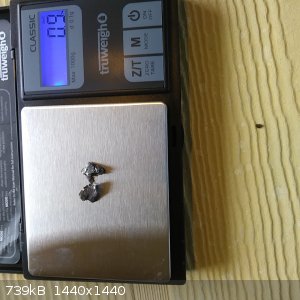 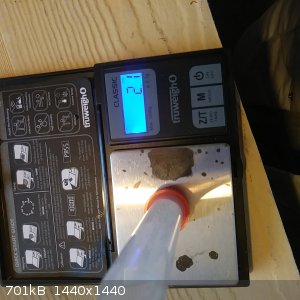 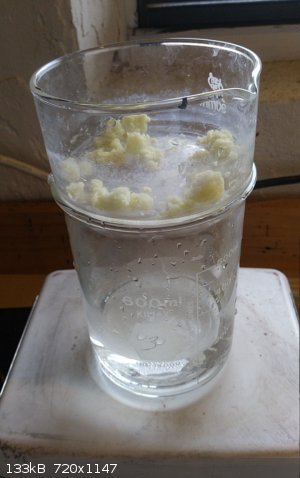 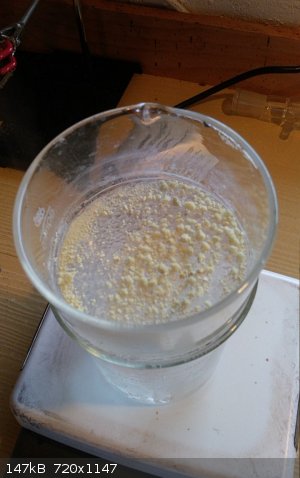
Within cells interlinked
Within cells interlinked
Within cells interlinked
|
|
|
j_sum1
Administrator
       
Posts: 6221
Registered: 4-10-2014
Location: Unmoved
Member Is Offline
Mood: Organised
|
|
Nice work, VV. Good write-up.
How clean was your acid? Any chance of picking up some Fe during the process?
|
|
|
fusso
International Hazard
    
Posts: 1922
Registered: 23-6-2017
Location: 4 ∥ universes ahead of you
Member Is Offline
|
|
I think u should use NH3(aq) instead of NaOH as NH4+ salts are volatile and u can drive them off by heating, that way u wont get Na contamination.
|
|
|
VSEPR_VOID
National Hazard
   
Posts: 719
Registered: 1-9-2017
Member Is Offline
Mood: Fullerenes
|
|
Quote: Originally posted by j_sum1  | Nice work, VV. Good write-up.
How clean was your acid? Any chance of picking up some Fe during the process? |
I do not know. My acid was clear but the addition of peroxide resulted in a yellow-green color which could be a contaminant oxidizing. The HCl was
clear out of the bottle.
Quote: Originally posted by fusso  |
I think u should use NH3(aq) instead of NaOH as NH4+ salts are volatile and u can drive them off by heating, that way u wont get Na contamination.
|
Ammonium chloride has a bp around 500C so that is a good idea. I could heat the resulting salt mixture using a torch. Using NaOH I removed most of the
NaCl with the hot water wash so I would not worry about it.
I have a vis. light spec in the lab so I will be running that test on it. I should see very clear spikes.
Within cells interlinked
Within cells interlinked
Within cells interlinked
|
|
|
Foeskes
Hazard to Others
  
Posts: 156
Registered: 25-2-2017
Member Is Offline
Mood: No Mood
|
|
Wikipedia says that holonium oxide will react with ammonium chloride forming holonium chloride, ammonia and water
|
|
|
fusso
International Hazard
    
Posts: 1922
Registered: 23-6-2017
Location: 4 ∥ universes ahead of you
Member Is Offline
|
|
Quote: Originally posted by Foeskes  | | Wikipedia says that holonium oxide will react with ammonium chloride forming holonium chloride, ammonia and water |
Oops, didnt know that...
|
|
|
VSEPR_VOID
National Hazard
   
Posts: 719
Registered: 1-9-2017
Member Is Offline
Mood: Fullerenes
|
|
I will use the holmium oxide in the future to make the corresponding ferrocyanide, by the reaction of it with hydroferrocyanic acid.
I am considering a method of preparing a double salt of holmium and copper, or some other metal.
Within cells interlinked
Within cells interlinked
Within cells interlinked
|
|
|
VSEPR_VOID
National Hazard
   
Posts: 719
Registered: 1-9-2017
Member Is Offline
Mood: Fullerenes
|
|
2 grams of Holmium oxide was reacted with 1.2g of hydroferrocyanic acid with strong stirring at 60 C. The solution turned from a 'nuclear'-green to a
deep purple-blue with the formation of a ultra-blue precipitate.
There was not enough product to isolate it with my current large filter.
When the solution was treated with sodium hydroxide a slight precipitate formed in addition to a change in color of the solution to a bright orange.
This orange solution when reacted with hydrochloric acid turned back to a deep blue (no precipitate). The following reaction is bellow describing this
course of events.
Ho4[Fe(CN)6]3 + 12NaOH -> 3Na4Fe(CN)6 + 4Ho(OH)3
Or a double salt of sodium and holmium formed in addition to some sodium ferrocyanide and holmium hydroxide, giving the soluble orange.
3Na4Fe(CN)6 + 4Ho(OH)3 + 12HCl -> 3H4Fe(CN)6 + 4Ho(OH)3 + 12NaCl
This reaction continues;
4Ho(OH)3 + 3H4Fe(CN)6 -> Ho4[Fe(CN)6]3 + 12H2O
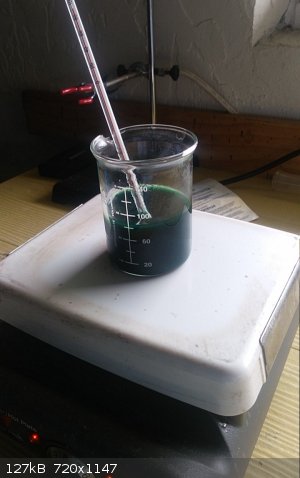
Within cells interlinked
Within cells interlinked
Within cells interlinked
|
|
|